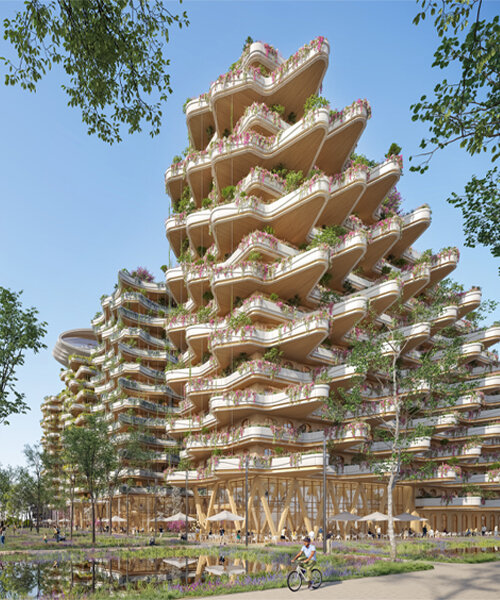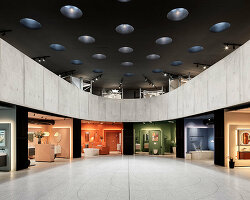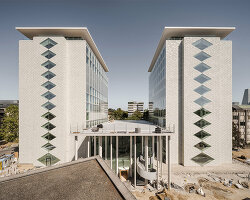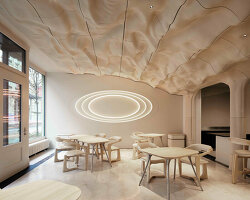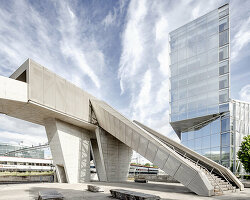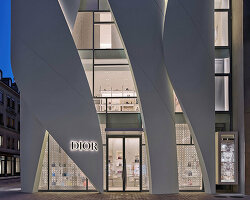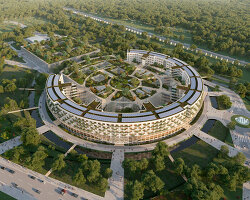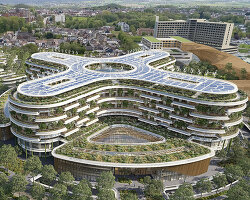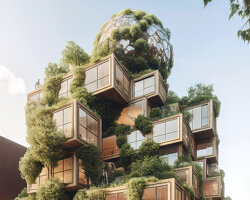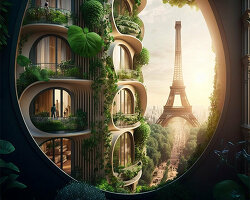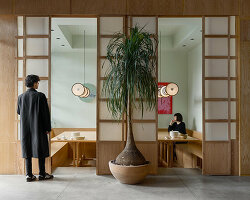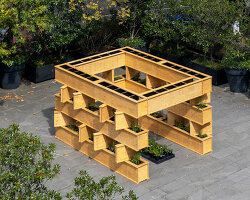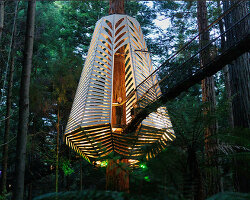the greenhouses by vincent callebaut architectures
In the heart of the Lake Geneva region of Switzerland, French architect Vincent Callebaut conceptualizes The Greenhouses, a car-free and timber eco-district with a 10,000 sqm urban park dedicated solely to pedestrians and cyclists. The project aims to reactivate the site’s flower cultivation heritage, which was once powered by the Old Greenhouses. Dominated by open land, extensive flowering meadows, and major fruit trees in the medium term, this island of urban freshness will benefit from evapotranspiration and ensure rainwater retention, offering its citizens a peaceful and almost utopic residential green space. Continuing the North-South mall of the Quartier des Cèdres, where Stefano Boeri’s 117 meter-high ‘Cedar Tower’ will be located, the park widens out over 10,000 sqm towards the south, welcoming public services shared with the surrounding urban fabric (children’s nursery, coworking, bars, restaurants, workshops, etc.) while allowing the continuity of the North-South soft mobility between Renens station and the Swiss Federal Institute of Technology in Lausanne, the famous ‘EPFL’.
In the East-West axis, the landscaped plan will revive the old ‘Traverse des Vergers’ (The Orchard Crossing), connecting the cantonal road 82-B-P in the commune of Ecublens to the West and Avenue de la Gare on the commune of Chavannes-Près-Renens to the east. Water also plays an important role, materializing through a large valley along the North-South mall, which flows into a panoramic water body along the Route de la Maladière. Phyto-purification lagoons and basins dedicated to aquaponics, permaculture, and urban agriculture will take shape between the buildings.
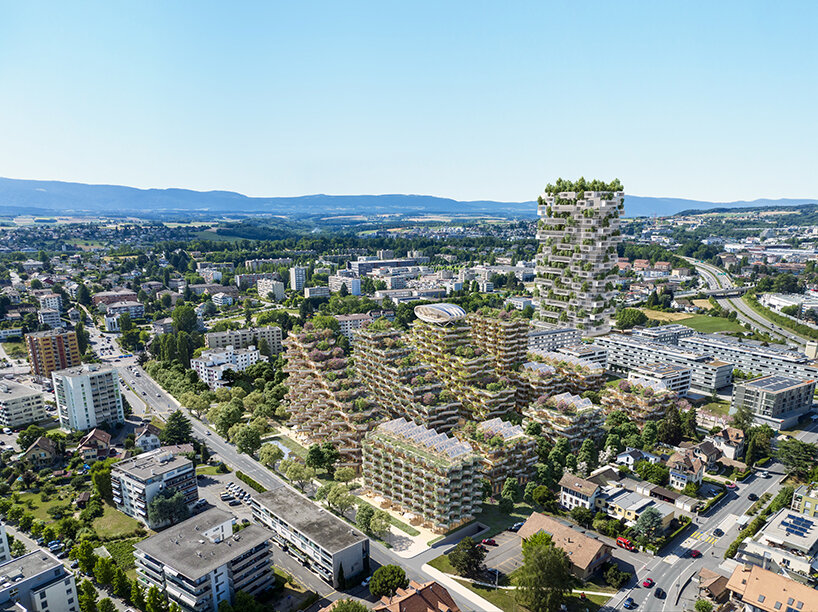
all renderings © Vincent Callebaut Architectures
On the buildings, rain chains inspired by Feng Shui choreograph the gravity runoff of rainwater from the green roofs to the orchards in the ground via the landscaped balconies. In addition to rainwater retention, osmotic pumps in the basement also filter gray water from the kitchens and bathrooms to ensure a continuous water supply for drip watering, cleaning, and sanitary facilities. Between the Chemin du Champ-Fleuri and the North-South pedestrian mall, surrounded by mirrors of water, ‘Le Nénuphar’ with voluptuous curves emerges, welcoming children into a new municipal nursery. Finally, to optimize the planting areas in the open ground and the number of mature trees, Vincent Callebaut (see more here) integrates the infrastructures dedicated to the planned parking lot almost exclusively under the buildings. The three access points to this car park at The Greenhouses discreetly integrate to the west, rue du Champ-Fleuri, to the south along the route de la Maladière, and the east, Avenue de la Gare.
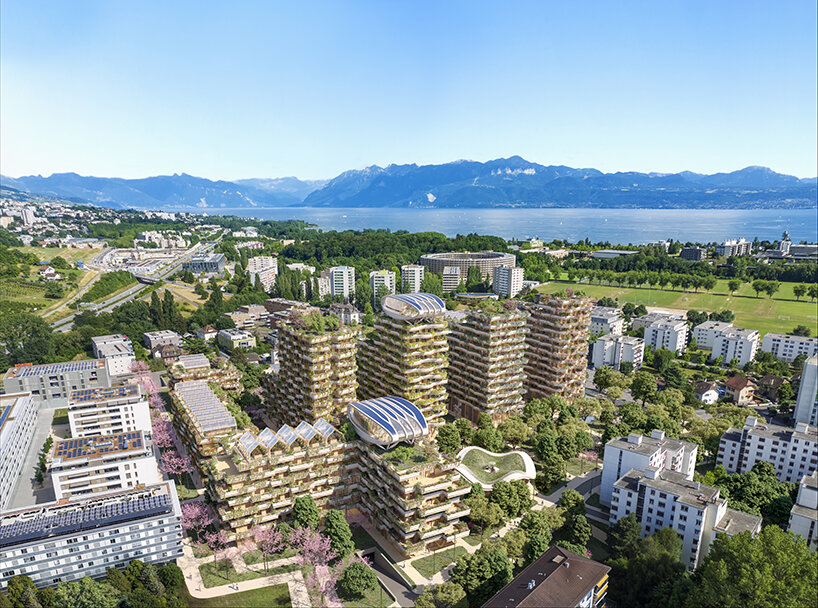
The Greenhouses is an island of urban freshness in the heart of the Lake Geneva region
carbon-absorbing cascades of duplex terraces & balconies
The Greenhouses project by Vincent Callebaut is based on a housing concept dubbed Sky Villas. It combines all the advantages of city apartments – close to services and culture – with the intimacy of an individual villa in the countryside with a private garden. Neither tower nor bar, cascades of duplex terraces and balconies installed in a staggered pattern open a cone of perspective towards Lake Geneva from the rooftops. While progressively spreading, this architecture sculpts and magnifies the views of the landscape. Furthermore, fighting against horizontal urban sprawl and land artificialization, the buildings integrate the rules of bioclimatism by respecting the sun’s path from East to West and the direction of the dominant winds from the South-West. All apartments are perfectly oriented like a comb, systematically articulating the living areas towards the south and the lake and the sleeping areas towards the North. 100% of the apartments face south, crossing and multi-oriented to offer the best quality of living.
In addition, each of these apartments benefits from large panoramic balconies framing views toward the Alps, Lake Geneva, and the Jura while providing the necessary shade to avoid overheating in living rooms. These landscaped terraces include string planters to cultivate plants and vegetable gardens as an extension of living rooms. This revegetation helps bioclimatize the temperature by lowering it by 3 to 5 degrees thanks to evapotranspiration and the filtering of solar radiation. Even more, residents can cultivate more than 30,000 plants and shrubs, capturing 170 tons of CO2 in the atmosphere of Chavannes-Près-Renens annually and creating a ‘carbon-absorbing’ architecture.
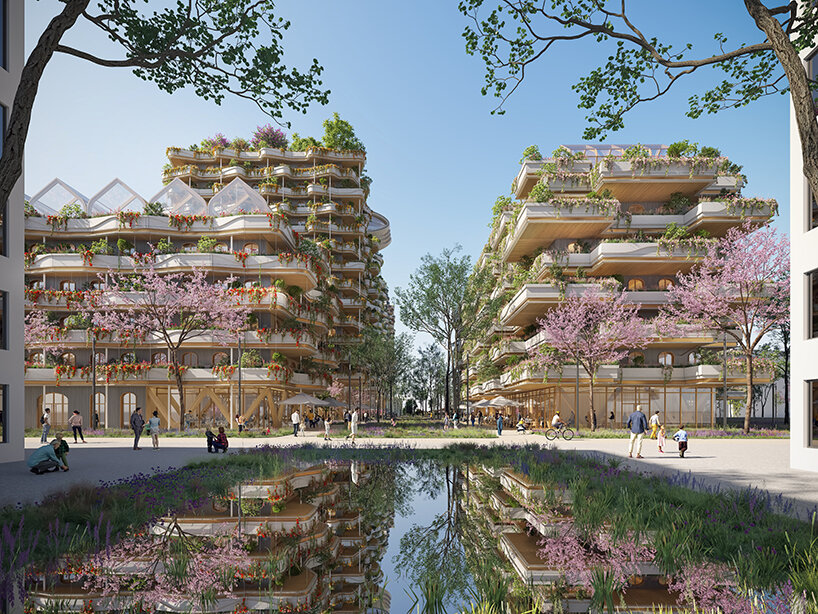
Vincent Callebaut aims to reactivate the site’s flower cultivation heritage
As for urban dimensions, the design proposes diverse experiences by spreading the built volumes from level 5 on the Avenue de la Gare side and its villas to level 14 on the North-South pedestrian mall side of a public park. This ensures coherent development of urbanization through building volumes, spaces, and circulation in harmony with nearby neighborhoods. The objective is to integrate the proposal as best as possible into the existing site’s heterogeneous buildings by proposing these hybrid geometries between the 105-meter-long bars of the Quartier des Cèdres and the Level+10 towers along the Route de la Maladière. The eco-district, already low in intrinsic carbon thanks to its bio-sourced construction materials, will ultimately be breathable and depolluting during its operation. Vincent Callebaut also proposes to assign to each building a specific color in the choice of plant species to create a kind of ‘rainbow gradient’ at the scale of the eco-district.
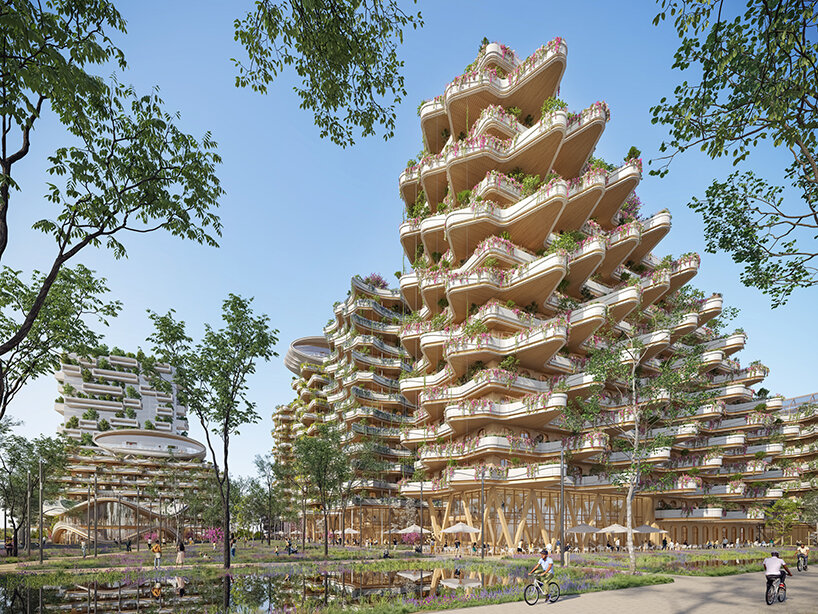
staggered terraces and balconies compose The Greenhouses
using CROSS LAMINATED TIMBER (CLT) for flexibility & scalability
The forest in the Canton of Vaud in Switzerland is integral to the Vaudois plateau and Lausanne. Professionals manage this vast forested area, ensuring environmental, economic, and social sustainability. Covering 40% of the Canton, it extends into the heart of the city. Amid the need for radical carbon footprint reduction, experts have employed the Cross Laminated Timber (CLT) technique, which involves stacking strips of wood perpendicularly and bonding them using organic structural adhesives. This method significantly reduces energy consumption compared to concrete and steel production and does not generate greenhouse gases. Combined with the wood’s slow burn rate, non-toxic combustion products, and optimal heat insulation, Vincent Callebaut saw CLT as the ideal choice for The Greenhouses project.
Envisioned to be built from sustainably harvested Swiss forests, the design embodies a carbon sequestration sink. Trees absorb carbon through photosynthesis, which is stored in the wood and remains trapped, preventing its release into the atmosphere and thus generating a negative carbon footprint. Structurally, the architect chose a solid wood construction with a flexible framework, allowing for reversible offices/housing configurations. The modular design, prefabricated off-site, optimizes construction time and cleanliness and offers the choice to personalize one’s apartments. The buildings also feature distinctive wooden balconies nodding to the local context. Southern facades are adorned with blond wood, while northern facades are covered with burnt timber, known as ‘Shu Sugi Ban’, which enhances resistance to fire, insects, and fungi. This technique aligns with the Japanese aesthetic of Wabi-Sabi, embracing natural processes and imperfections.
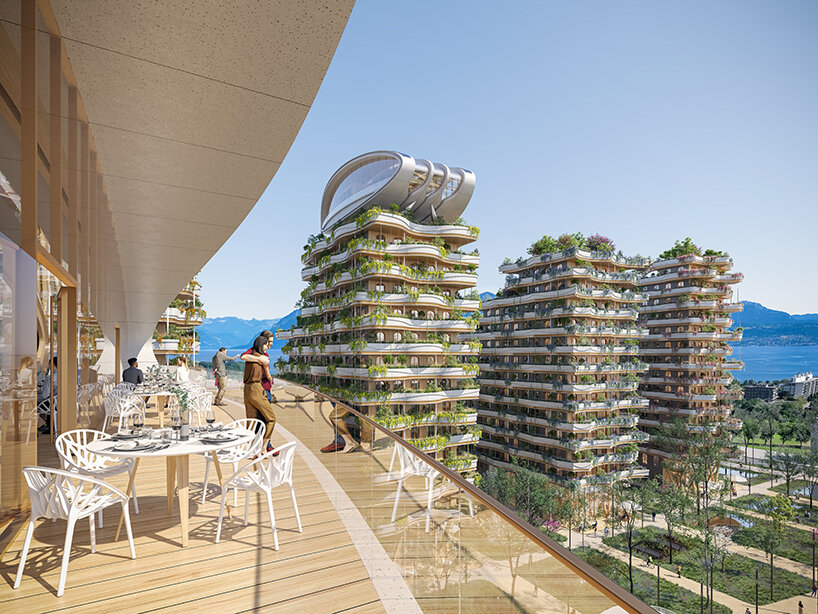
framing scenic views toward Lake Geneva
BIOCLIMATISM, RENEWABLE ENERGY & URBAN AGRICULTURE
Besides low-carbon CLT construction, the architect’s efforts also focus on passive systems and renewable energies to further reduce the carbon footprint. First, the buildings benefit from external insulation thanks to materials like thatch, hemp, cellulose wadding, or even wood wool sourced from local sawmills. To ensure natural ventilation in each apartment, wind chimneys cross the vertical circulation cores over their entire height. These chimneys suck in outside air at 30 degrees in summer from the orchards planted on the ground floor. This hot air passes under the foundations where the earth’s thermal inertia is constant all year round at 18 degrees. The naturally cooled air to 22 degrees is then blown into the apartments like in a termite mound, with an energy-saving rate of up to 70%. Stairwells and elevator shafts are also placed along the north facade to benefit from natural ventilation.
In addition to the landscaped balconies, Vincent Callebaut injects standardized greenhouses and small urban aquaponic farms (cultivated in permaculture) into ‘Les Tremplins’, ‘Les Créneaux’, ‘Les Arcs’ and ‘Les Roches’ buildings. Aquaponics combines fish breeding and plant cultivation, allowing these sky farms to produce up to 25 kilos/sqm of fruits and vegetables annually. These foods are grown organically with 90% water savings using natural fertilizers. The fish feed the plants with nitrate, and in return, the plants produce oxygen for the fish. The water purified and then returned to the fish tank; the cycle can start again. A ‘living market’ allows residents to stock up on farm products. The greenhouses, naturally lit all year round, benefit from additional silicon cells integrated into the double glazing of the BIPV roofs to produce electricity. The green roofs installed at the top of the tallest buildings integrate biodiversity gardens with veritable fifth facades that make way for ecological corridors favorable to diverse endemic fauna and flora. Finally, a biomass boiler and a field of geothermal probes are designed to produce shared hot water at a reasonable price.
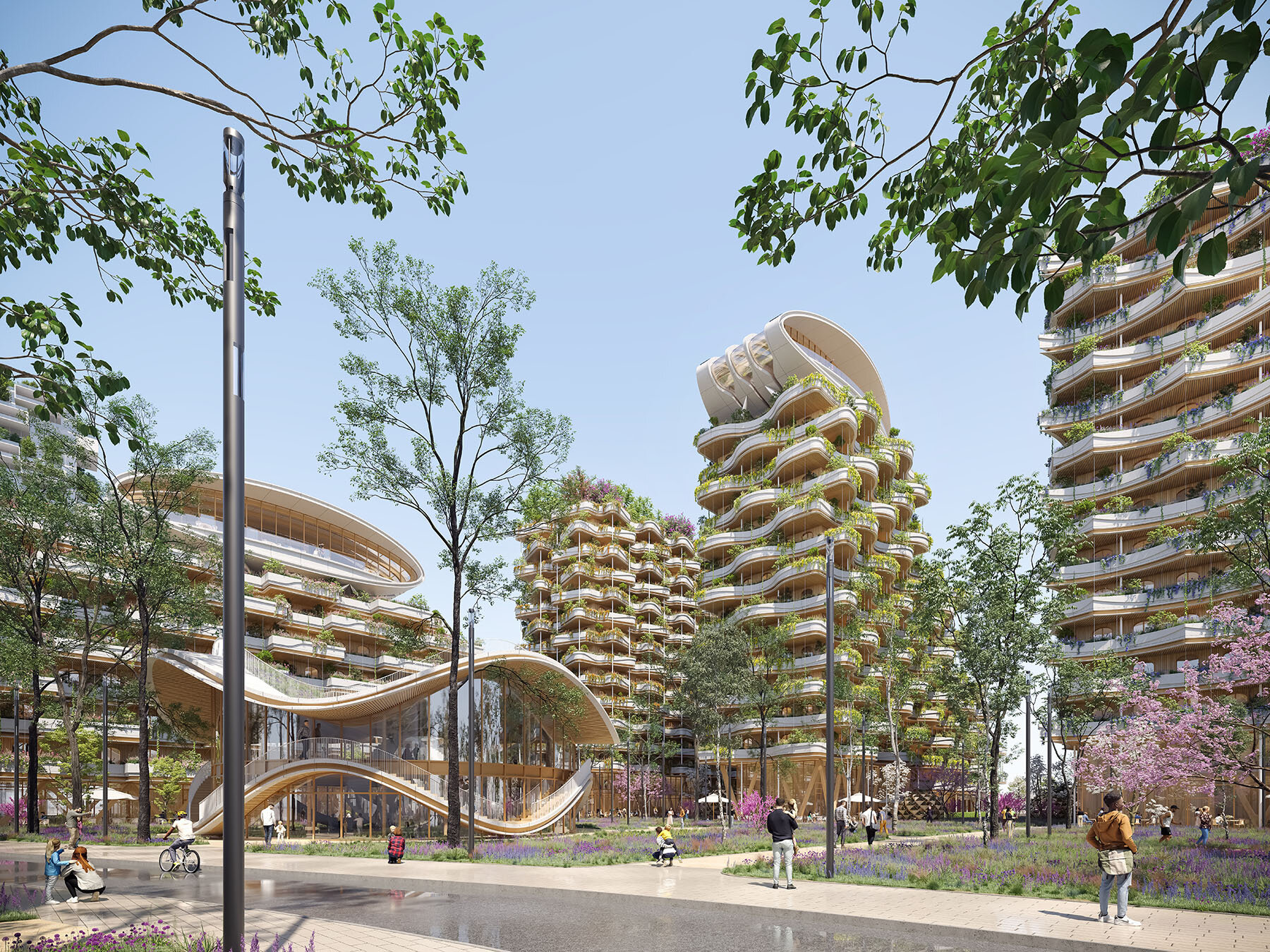
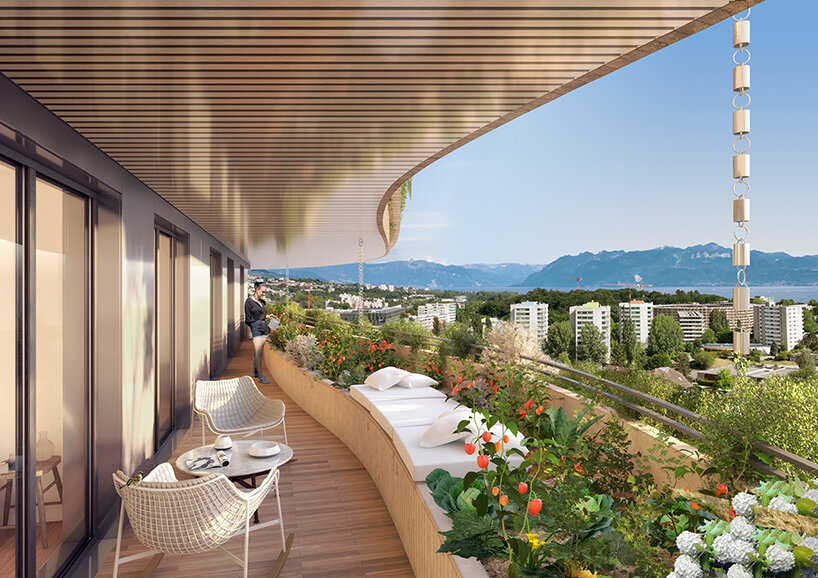
bioclimatic balconies
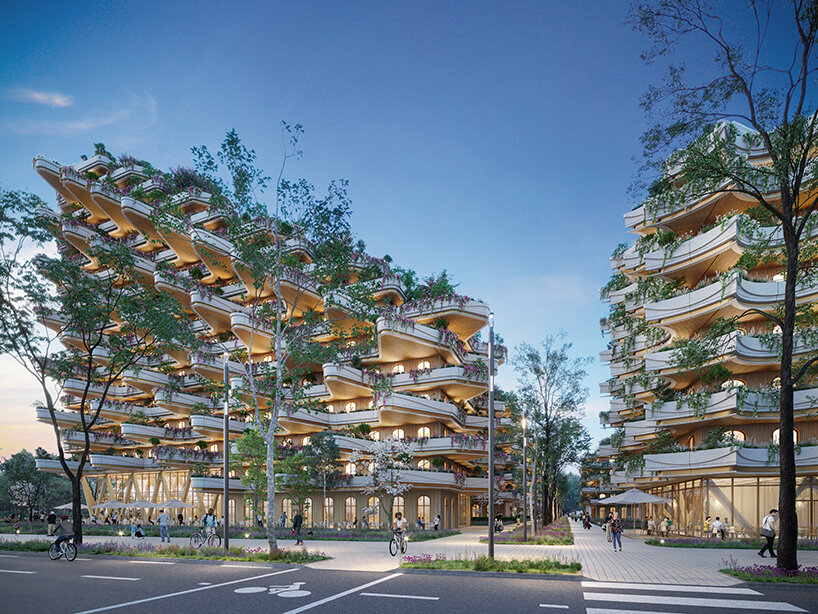
a fully pedestrianized eco-district made using a CLT construction
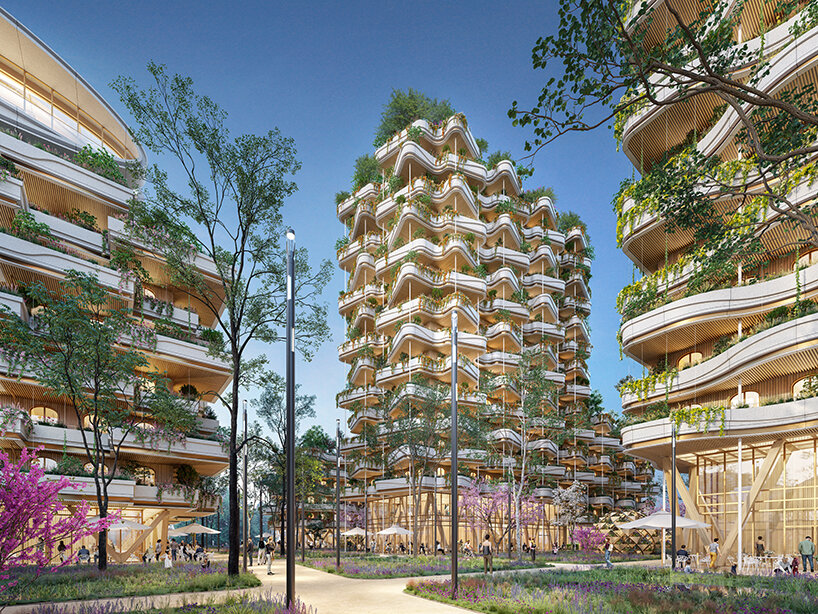
the modular design for The Greenhouses will be prefabricated off-site
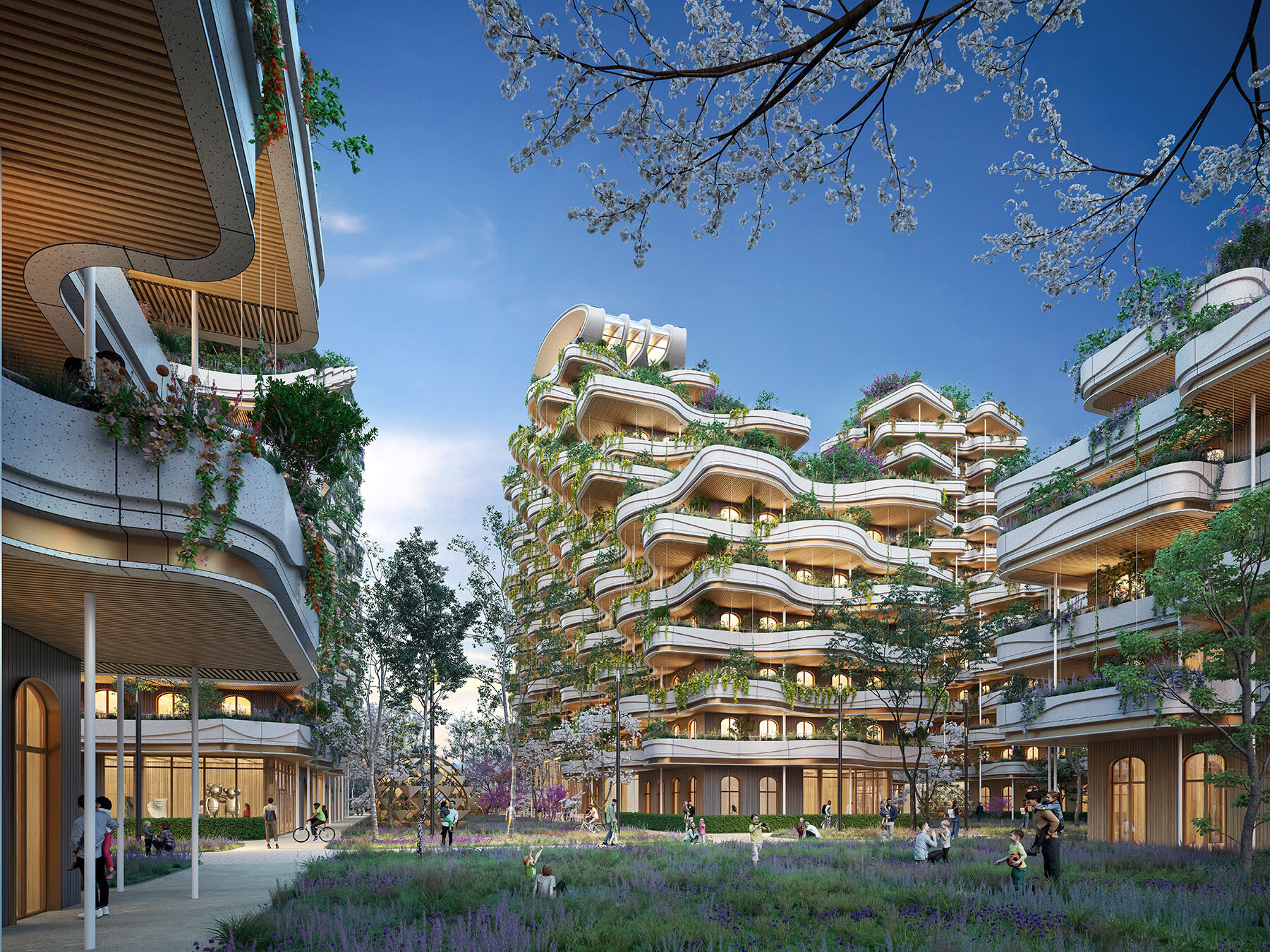
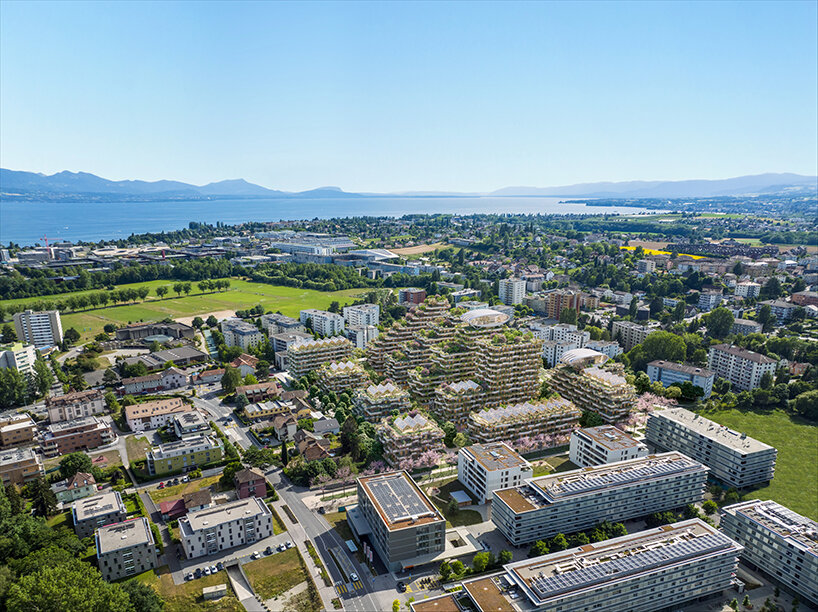
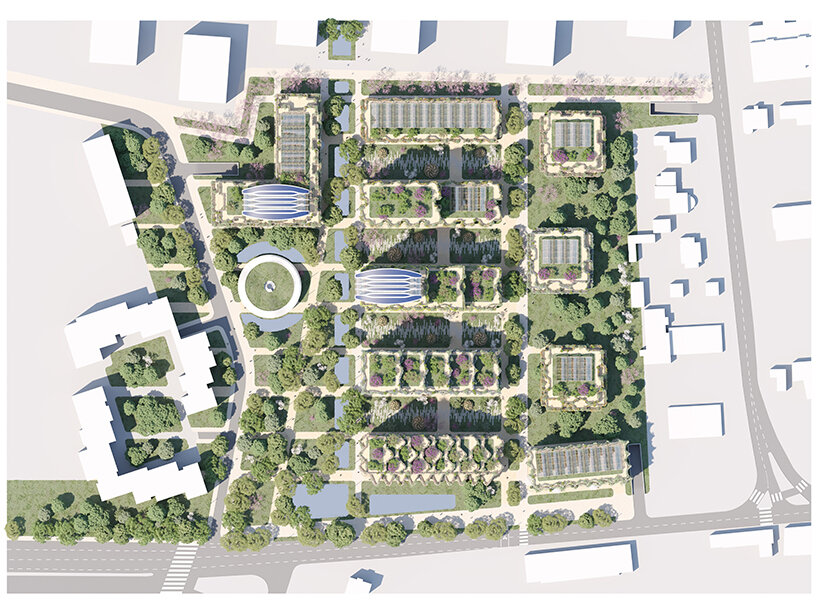
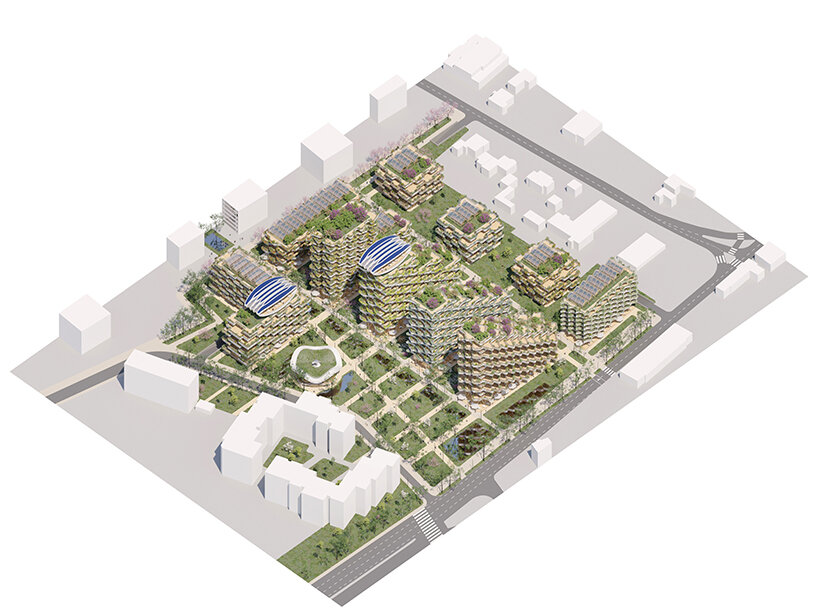
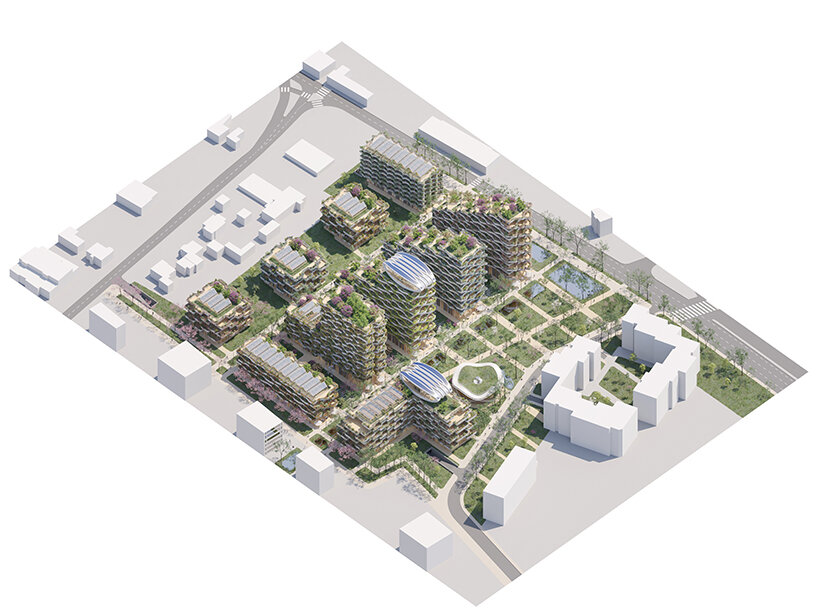
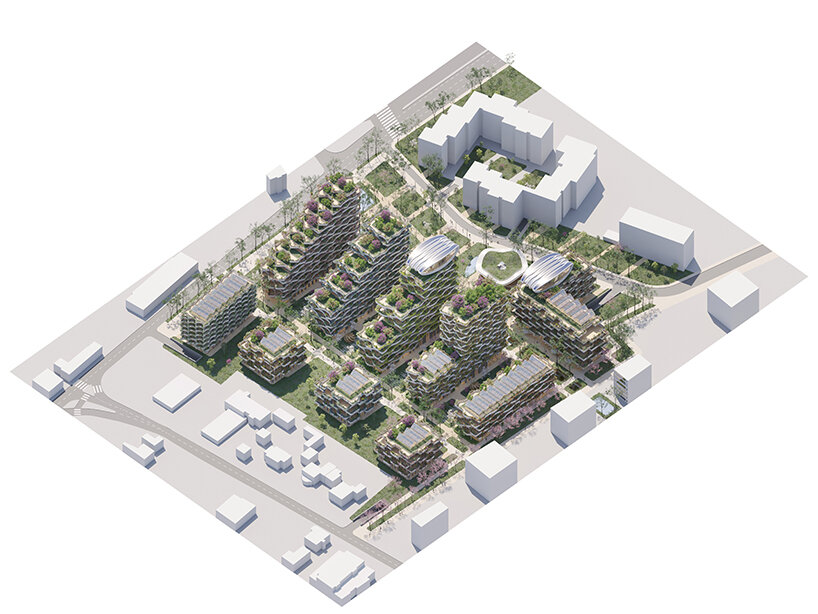
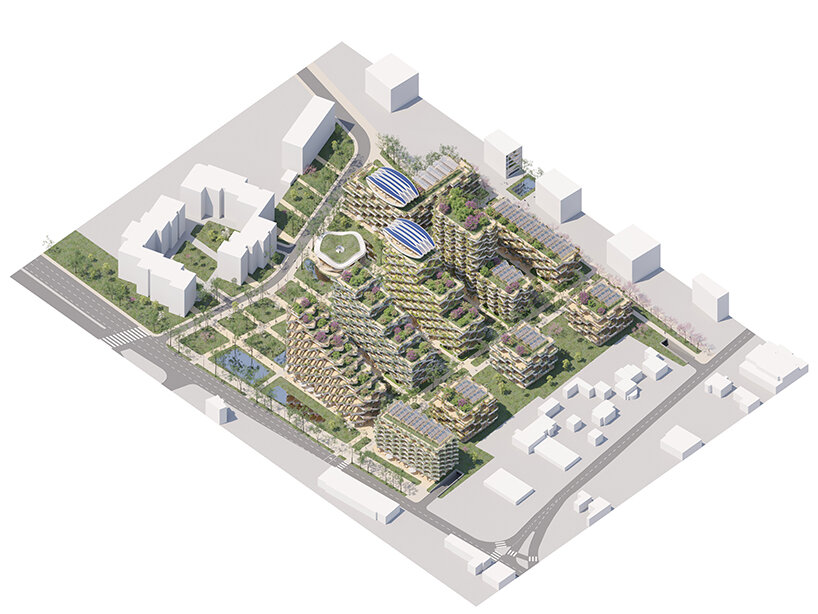
project info:
name: The Greenhouses
location: Chavannes-Près-Renens, Ouest Lausannois District, Canton of Vaud, Switzerland
architect: Vincent Callebaut | @vincentcallebautarchitectures
client: All Real Romandie, project lead by Outgoing Head Anne-Marie Loeillet
green certification: Swiss Minergie Label for low-energy-consumption buildings
total surface area: 52,805 sqm (superstructure)
children’s nursery area: 750 sqm
public panoramic rooftops area: 700 sqm
public amenities area: 5,280 sqm
public park area: 10,000 sqm
housing area: 47,525 sqm (480 units)
architecture in switzerland (240)
vincent callebaut architectures (37)
wood and timber architecture and design (981)
PRODUCT LIBRARY
a diverse digital database that acts as a valuable guide in gaining insight and information about a product directly from the manufacturer, and serves as a rich reference point in developing a project or scheme.
